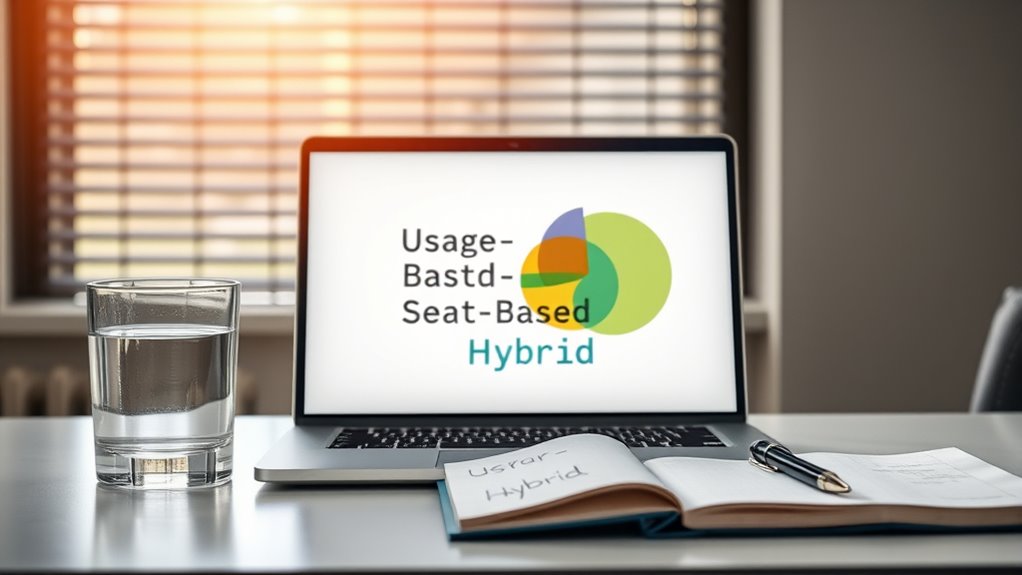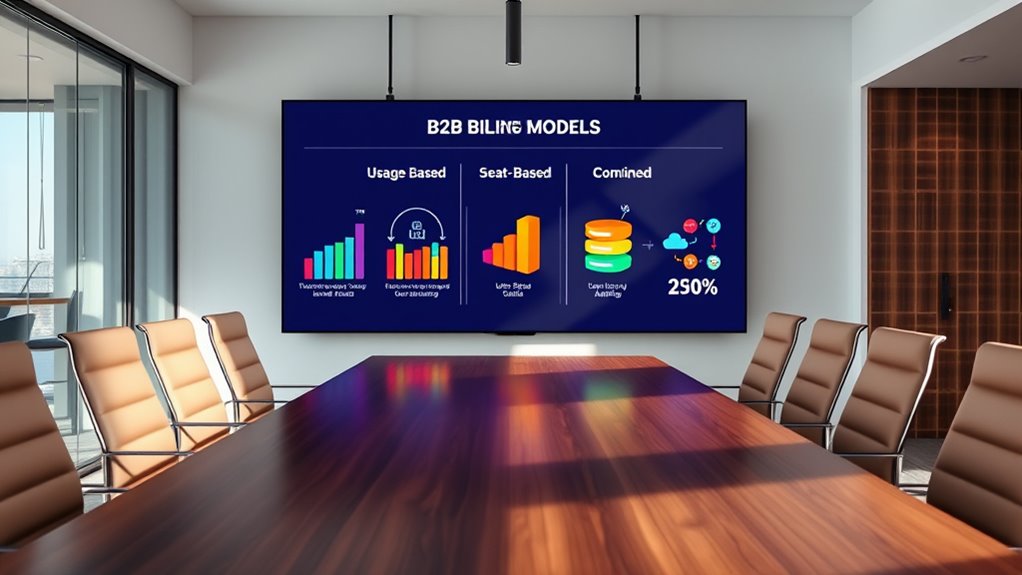When choosing a billing model for your B2B SaaS, consider whether your customers prefer predictable costs or flexible pay-as-you-go options. Usage-based models appeal to clients wanting usage flexibility, while seat-based billing offers predictability. Hybrids combine both approaches, providing tailored solutions for diverse needs. Your choice impacts revenue stability and customer satisfaction. To discover how each model fits different scenarios and how transparency can boost trust, explore further details below.
Key Takeaways
- Usage-based billing charges customers based on actual usage, appealing to flexibility and pay-as-you-go preferences.
- Seat-based billing charges a fixed fee per user, offering predictability and simplicity for stable customer needs.
- Hybrid models combine usage and seat charges, providing customizable pricing to cater to diverse customer segments.
- Usage models support fluctuating usage patterns, while seat models favor predictable revenue; hybrids blend both benefits.
- Transparent, customer-centric billing fosters trust, enhances satisfaction, and aligns with business goals across all models.

Are you wondering how to choose the right billing model for your B2B SaaS product? The answer hinges on understanding your customers and the kind of pricing flexibility you want to offer. Different billing models cater to distinct customer segmentation strategies, making it essential to evaluate your target audience’s needs and preferences. When selecting a model, consider whether your customers prefer predictable costs or more usage-based, scalable options. This decision impacts revenue stability, customer satisfaction, and overall business growth. Usage-based billing appeals to customers who value flexibility and pay for what they use. If your clients have fluctuating needs or desire control over their expenses, this model can be highly attractive. It allows you to align your revenue with actual product usage, which can foster trust and transparency. It also requires robust tracking systems and clear communication to avoid surprises that might frustrate customers. Usage billing also enables you to implement pricing tiers based on different usage levels, accommodating various customer segments from small businesses to large enterprises. Incorporating accurate measurement methods is crucial for ensuring fair billing and maintaining customer trust. Additionally, offering clear and detailed billing reports can enhance transparency and customer satisfaction. Hybrid models combine elements of usage-based and seat-based billing, giving you the ability to tailor offerings to different customer segments. For example, you might charge a base fee per seat and add usage charges for extra features or capacity. This approach offers greater pricing flexibility, helping you address diverse customer needs without overcomplicating your billing process. It also allows you to segment customers more effectively, providing customized packages that appeal to different industries or company sizes. Implementing such models can be more complex, but they can maximize revenue potential by capturing value across multiple dimensions. Ultimately, the best billing model depends on your product, customer preferences, and your strategic goals. Analyzing your customer segmentation and understanding their willingness to pay for various features or usage levels will guide you toward a model that balances flexibility with predictability, ensuring long-term success. Recognizing the importance of customer-centric approaches and clear communication can significantly improve customer retention and trust. Considering narcissistic abuse recovery principles, clarity and transparency in your billing approach can foster trust and build stronger customer relationships, essential for sustainable growth. Recognizing the importance of effective customer communication can also help prevent misunderstandings and promote loyalty, especially when utilizing flexible billing options. Incorporating transparent pricing strategies can further strengthen trust by making your billing practices clear and straightforward, aligning with ethical business standards.
Frequently Asked Questions
How Do Billing Models Impact Customer Retention?
Billing models substantially impact customer retention by influencing customer loyalty and revenue predictability. If you choose a flexible, usage-based model, customers appreciate tailored costs, boosting loyalty, but unpredictable revenue streams may concern you. Conversely, seat-based models foster steady revenue predictability, encouraging long-term commitment. Hybrid models balance these benefits, enhancing loyalty and revenue stability. Your choice should align with your customers’ needs, helping you maintain retention while ensuring predictable cash flow.
What Are the Hidden Costs of Usage-Based Billing?
When considering usage-based billing, you might face hidden costs like fluctuating revenue and issues with pricing transparency. You could struggle with revenue predictability because usage varies month-to-month, making it hard to plan finances. Additionally, customers may feel uncertain about costs, which impacts trust. These hidden costs can lead to customer dissatisfaction and unpredictable cash flow, so it’s essential to monitor usage patterns and communicate costs clearly to maintain stability.
How to Choose the Best Billing Model for My Saas?
Thinking about the best billing model? Ironically, the trick is balancing pricing flexibility with revenue predictability. You might love usage-based plans for flexibility, but they can mess with your cash flow. Seat-based models offer predictability but might limit growth. Hybrid options could be the compromise you need—giving your customers options while keeping your revenue steady. So, assess your growth goals and cash flow needs before choosing the right model.
Can Billing Models Be Combined or Changed Easily?
You can definitely combine billing models or change them, but it requires billing flexibility and careful planning for smooth model migration. Many SaaS platforms support hybrid billing options to cater to different customer needs. When switching models, communicate clearly with your clients, update your billing system, and consider phased transitions to minimize disruption. Flexibility is key to adapting your billing approach as your business and customer base evolve.
What Legal Considerations Exist for Different Billing Models?
Think of your billing model as a ship steering legal waters. You must guarantee your contracts clearly define terms to prevent disputes, making enforcement straightforward. Compliance regulations like data protection laws also shape your approach. Changing or combining models requires updating contracts to reflect new terms, avoiding legal pitfalls. Staying vigilant helps you steer smoothly through contract enforcement and regulatory compliance, keeping your SaaS business afloat and avoiding costly legal storms.
Conclusion
Choosing the right billing model depends on your customers’ needs, your revenue goals, and your product’s nature. Usage-based models offer flexibility, seat-based models provide predictability, and hybrids combine both advantages. By understanding these options, you can tailor your approach, optimize your revenue, and enhance customer satisfaction. Ultimately, selecting the right model isn’t just about numbers; it’s about aligning your billing strategy with your business vision and your customers’ expectations.










